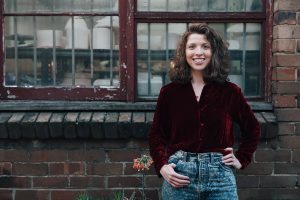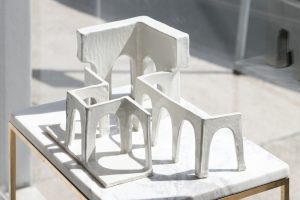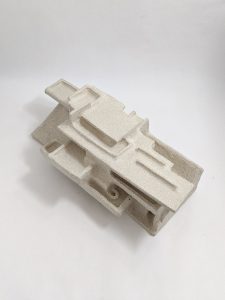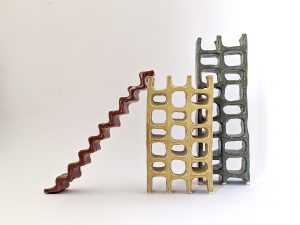This Sunday I want to introduce you to Natalie Rosin.
Natalie is a graduate architect and ceramicist from Sydney, Australia. Jasmine and I are both in-love with the work Natalie creates and so were thrilled when she agreed to an interview highlighting her artistic practice and connection to architecture. Natalie creates the most sophisticated and delicate of architectural thoughts though ceramic sculptures and vessels.
“To merge ceramics with architectural thought introduces a place open to experimentation, unexplored forms and intuitive structures, forming new expectations from the spaces we inhabit and the environments built around us.” – Natalie Rosin, ceramicist

Natalie Rosin, Photographed by Flore Vallery-Radot.
I love the way in which you have combined your two loves; architecture and ceramics. What came first? Your love for clay or buildings?
I first studied architecture at university. While completing my Masters degree I enrolled in a ceramics elective and this is when I was first introduced to clay. At the time I wasn’t sure how to combine the two disciplines, but now I am exploring these moments of connection.
What characteristic do you love most about clay?
I love how this piece of the earth, presenting itself in a simple ball or slab shape can be transformed into infinite three dimensional configurations or forms.
Clay is often used for its ability to create organic shapes; however, it appears most of the sculptures you create have rigid qualities. How do you use the qualities of clay to create your desired outcome?
To form my more orthogonal, strictly planar structures involves really understanding the properties of clay and how it dries. I use a slab roller, which allows a chunk of clay to be evenly rolled out as a flat surface. Once I do this, I do not immediately work with the clay to create my forms, instead I then wait many hours, sometimes 12 hours, before working with the material. This achieves the desired moisture content for the clay to be rigid but not too dry and requires a lot of patience.
Do you have a very set idea of how you want every piece to end up or do you allow the process and attributes of clay to influence the design and outcome?
My architecture background aims to be precise to the millimeter, while my experience with clay is well aware that this is a lost cause. I like to embrace the unpredictable properties of clay in my sculptural works, while at the same time try to achieve at least a small sense of control over the final outcome by understanding how clay can develop and move during the different firing and drying stages of the process.
Physically modelling the sculptures, does this build a strong connection with each piece? Is this connection something you avoid or honour due to clay’s temperamental manners?
There is an emotional balance I try and maintain. While of course there is love in each piece I make, having devoted my time, energy, my thoughts into each form, there is also a detachment. Often pieces formed with clay can crack and break during the different stages of making and so I have learned that if you’re reminded of this every step of the journey the disappointment of a piece not working out is less harsh. Lets call it ceramic stoicism.

‘MCM’ sculptures by Natalie Rosin at Saint Cloche Gallery. Photograph by Jacqui Turk. 2019
I think your MCM sculpture may be my favourite! What was the thought and design process behind this selection of pieces?
The pieces I created for the ‘MCM’ exhibition at Saint Cloche were inspired by Mid Century Modern architectural gems located in Palm Springs in California USA. I selected key buildings that really spoke to me, and sculpted a collection of works inspired by this period of architectural design.
Do you believe that your architecture degree was essential for your artistic practice today?
I do believe my architecture degree has informed my ceramic practice. I was introduced to ceramics via my architecture studies and have used certain skills studied in architecture school to guide my method of sculpting clay.

Falling water Commission by Natalie Rosin Private Commission 2020.
Who is your most inspiring Architect, Artist and Sculptor?
To me Antonia Guadi was all three of these, his works are out of this world in my mind.
Where do you gain your architectural inspiration? Do you like to physically visit and experience urban spaces, or does it come from your own imagination?
My architectural inspiration comes from both examples I have physically seen in person or through images, as well as from my own concepts and ideas. For instance, I enjoy sculpting brutalist architecture because of their interesting forms in addition to how well concrete translates to the clay medium. In these instances, I try and really study the building, aiming to include enough features for the sculpture to be recognisable but not too representational. On the other hand, I also enjoy being spontaneous and forming pieces without sketching or planning things out, I call this sketching with clay.
Are you inspired by the Australian vernacular architecture and Urban environment? Are you inspired by rural environments at all?
I am definitely inspired by Australian architecture. The works of Harry Seidler, an Australian modernist architect, have been a strong influence on the forms I create.
You mention enjoying creating unexplored forms and idealistic architectural forms, do you ever consider taking these small-scale ceramic sculptures into architectural pavilions? In turn using your ceramics to inform future architecture.
This is a definite possibility but not something I have explored in my career as of yet.
Do you have any projects coming up you want to talk about?
I have an exhibition coming up very soon at Saint Cloche gallery in Paddington, Sydney titled ‘CHROMATIC’ it is inspired by the colourful and surreal anomalies of the built world. Three strong influences for this exhibition include Spanish architect Ricardo Bofill, Swiss-French architect Le Corbusier and Mexican architect LuisBarragan.The show runs from 14th–25th October 2020. More information can be found here www.saintcloche.com/portfolios/chromatic .

‘CHROMATIC’ Sculptures by Natalie Rosin for Saint Cloche 2020.
If you would like to find out more about Natalie you can find her at www.natalie-rosen.com or over on instagram at @natrosin
I am really enjoying doing these fortnightly blog posts and would love to hear back from you in comments with ideas for artists with an interest in Architecture who I can find out more about for you.
Thank you..
Amy X


Recent Comments